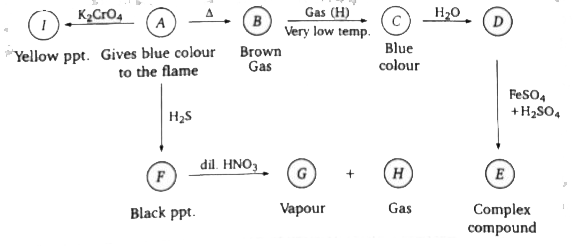
Q. Yellow ppt. of compound (I) is insoluble in:
A
NaOH
B
CH3COOH
C
dil. HNO3
D
none
Text Solution
The correct Answer is:B
2Pb(NO3)(2)→2PbO+4NO(2)↑⏐+O2↑⏐
NO2(B)+NO(H)low−−→temp.N2O5(Blue colour liquid)
N2O5(C)+H2O→2HNO2(D)
2HNO2+2FeSO4+H2SO4→Fe(SO3)(3)+2NO+2H(2)O
FeSO4(aq)+NO→[Fe(H2O)(5)NO](E) (Brown ring)SO(4)
Pb(NO3)(2)+H(2)S→PbS↓(G) (yellot ppt.)→Pb(NO3)(2)+2K++2NO(3)−
Pb(NO3)(2)+K(2)CrO4→PbCrO4↓(I) (yellow ppt.)+2K++2NO−3
PbCrO4+4OH−→[Pb(OH)4]2−soluble+CrO−4
2PbCrO4+4HNO3→2Pb(NO3)2+H2Cr2O7+H2O
|
Topper's Solved these Questions
- p-BLOCK ELEMENTSBOOK - VK JAISWAL ENGLISHCHAPTER - p-BLOCK ELEMENTSEXERCISE - ONE OR MORE ANSWERS IS/ARE CORRECT
95 Videos
- p-BLOCK ELEMENTSBOOK - VK JAISWAL ENGLISHCHAPTER - p-BLOCK ELEMENTSEXERCISE - MATCH THE COLUMN
24 Videos
- p-BLOCK ELEMENTSBOOK - VK JAISWAL ENGLISHCHAPTER - p-BLOCK ELEMENTSEXERCISE - LEVEL 2
97 Videos
- METALLURGYBOOK - VK JAISWAL ENGLISHCHAPTER - METALLURGYEXERCISE - ASSERTION-REASON TYPE QUESTIONS
29 Videos
- PERIODIC PROPERTIESBOOK - VK JAISWAL ENGLISHCHAPTER - PERIODIC PROPERTIESEXERCISE - MATCH THE COLUMN
11 Videos
Similar Questions
Knowledge Check
Black colour compound A is insoluble in HCI solution but soluble in aqua regia due to formation of compound B. When excess of KCN solution is added to compound B, it gives initially green ppt. C and finally gives yellow solution due to formation of D. compound D and its EAN are respectively.
AK2[Ni(CN)4],34BK3[Cu(CN)4],35CK3[Co(CN)6],36DK4[Fe(CN)6],36A metal chloride solution on mixing with K2CrO4 solution gives a yellow ppt, which are insoluble in water. The metal may be
AmercuryBzincCsilverDleadA compound (A) is greenish crystalline salt which gave the following results :
i) Addition of BaCl2 solution to solution of (A) results in the formation of a white ppt. (B), which is insoluble in dil. HCl.
ii) On heating (A), water vapours and two oxides of sulphur, (C ) and (D) are liberated leaving a red brown residue (E).
iii) (E) dissolves in warm conc. HCl to give a yellow solution (F).
iv) With H2S, the solution (F) yields a pale yellow ppt. (G), which when filtered, leaves a greenish filtrate (H).
v) Solution (F) on treatment with thiocyanate ions gives blood red coloured compound (I).
Identify the substances from (A) to (I).
Yellow ppt (G) is a :Ametal sulphateBmetal sulphideCmetallic precipitateDsulphur
A certain compound (X) is used in laboratory for analysis. Its aq. solution gave the following reactions.
On addition to Ag+ ion solution, a yellow ppt. is obtained which is insoluble in NH4OH. Identify (X), giving reactions
View SolutionX−_(aq)+AgNO3→AgX↓bright yellow ppt
Bright yellow ppt (AgX) is insouluble in conc. ammonia solution.Then find out X.
View SolutionX−_(aq)+AgNO3→AgX↓bright yellow ppt
Bright yellow ppt (AgX) is insouluble in conc. ammonia solution.Then find out X.
View SolutionA compound is treated with iodine and an alkali. It gives a yellow ppt. The compound is ?
View SolutionA compound is treated with iodine and an alkali. It gives a yellow ppt. The compound is ?
View Solution
